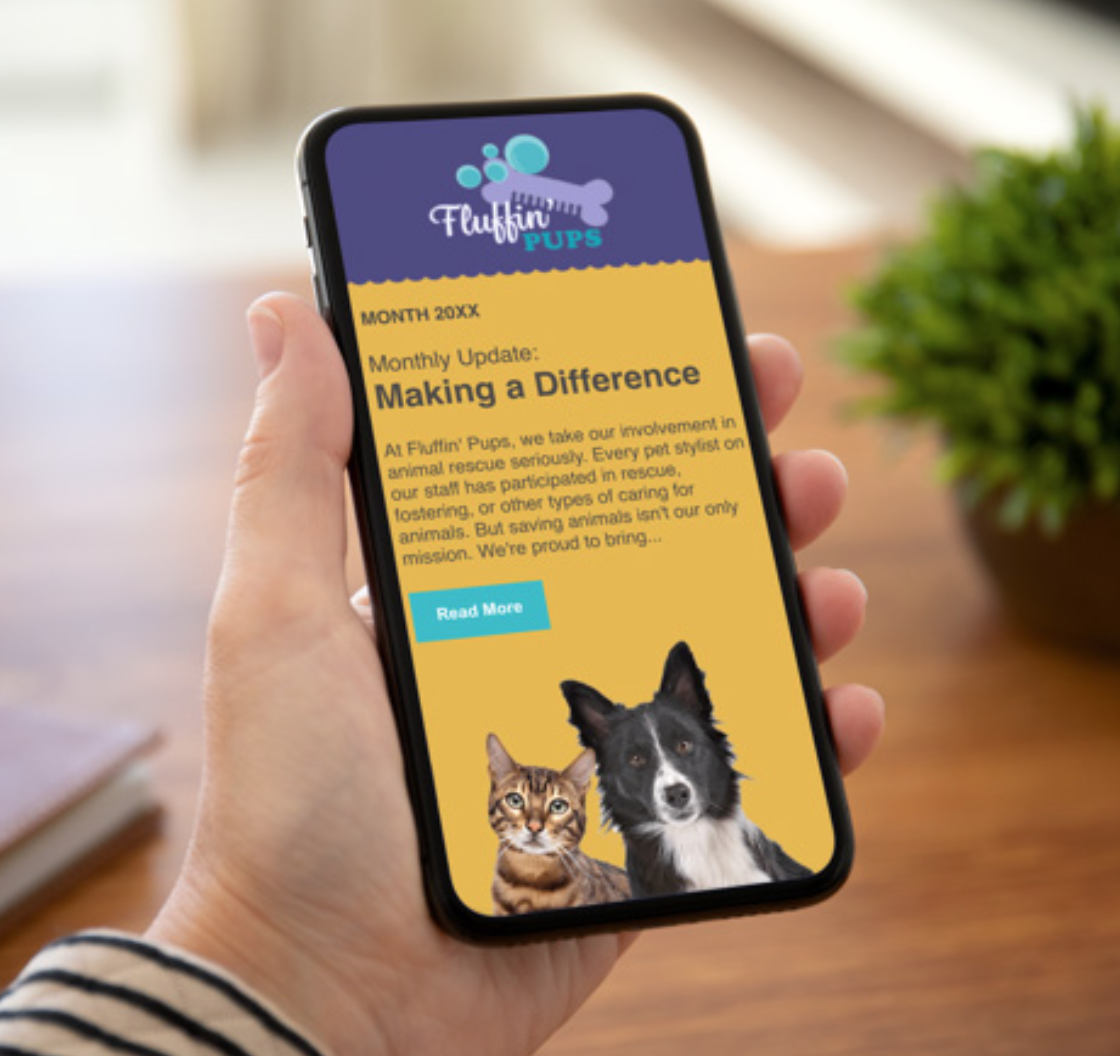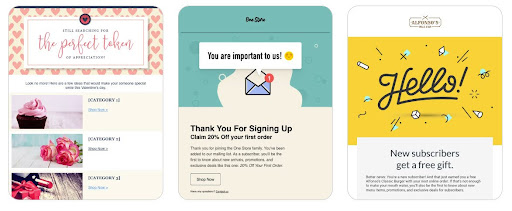
When it comes to communications, many companies focus primarily on crafting their messages to customers. However, internal communications are equally important to your business success. The company newsletter, in particular, is a valuable tool for keeping your employees informed, engaged, and on the same page.
Drafting a successful company newsletter isn’t as tricky as it sounds, especially when you have the right tools. Discover company newsletter examples to learn what works best in these communications and how to craft your own.
What is a company newsletter?
Most employees have probably received a company or nonprofit newsletter at one point, but they may not even realize that’s what it was. So, what is a newsletter and what are some examples?
A company newsletter is a type of communication typically shared by email that relays relevant information with the business’s internal team. These newsletters go out to everyone in your organization rather than specific departments or individuals. Communicating the same message to every member of your organization allows you to break down information silos and ensure everyone is informed.
This could include things like a company update, helpful tips for the workplace, or even internal opportunities.
Objectives of company newsletters
Companies have several reasons for sharing newsletter content with their employees. Some of the objectives of company newsletters include:
- Inform employees: If something is happening in the company that all employees need to know, sending out a newsletter is an ideal way to share that information.
- Keep employees engaged: Staying up-to-date on company happenings through the newsletter helps employees feel more connected.
- Strengthen company culture: Sharing a newsletter with all employees contributes to a more inclusive, collective company culture.
- Reduce email volume: Sending one newsletter with all the key updates employees should know allows companies to reduce the number of emails sent back and forth, which distracts employees.
Your reasons for sending a newsletter can vary. You may want to establish or reinforce your brand with consistent internal messaging. Or, perhaps you’re interested in opening up important dialogue with your employees. Whatever your objective is for sending company newsletters, you need to ensure it’s both informative and engaging for the best results.
What makes a good company newsletter?
A “good” newsletter is hard to define since different styles and types of newsletters are well suited for different objectives. Still, the best company newsletter examples have some qualities in common. These are some of the elements of effective employee newsletters:
- A concise, simple message
- Relevant and interesting information for your employees
- Images that complement the message you’re sharing
- An eye-catching design that does not distract from the message
- Involvement from your employees (i.e., quotes, images, etc.)
- Calls-to-action prompting readers to take the next steps when applicable
- Links to other relevant company communications, such as a blog or social media profiles
Also, make sure to maintain proper email etiquette in your newsletters. Proofread each message to avoid mistakes, stick to your brand voice, and format your newsletter to appear clearly on desktop and mobile devices.
Ensuring consistency between your newsletters will further strengthen your internal brand. You can use the same general newsletter email template whenever you send the newsletter and update the message with the most current information.
25 company newsletter ideas
What do you write in a company newsletter? Here are some newsletter content ideas to keep your employees engaged.
1. New team member announcement
When a new employee joins your team, consider announcing their hiring in the next company newsletter. Making the announcement this way will provide a warm welcome to the new employee and allow the rest of the team to learn a little bit more about them.
2. Personal anniversaries and celebrations
Announce work anniversaries to celebrate employees who have been with the company for many years. If someone reaches 10 years with the company, for example, mention this in the newsletter to highlight their commitment.
3. Recommendations and must-sees
If you have any recommendations that would interest your team members, a list of those must-see items would make a great addition to any company newsletter. Include books, videos, or articles related to your business or professional development.
4. Special day events
When special days like the winter holidays and Employee Appreciation Day come around, announce them in the newsletter. These announcements help employees know what events are on the horizon.
5. Competitions and contests
Contests and competitions foster engagement and company spirit among your employees. Announce them in the newsletter or, in the case of puzzles and other digital contests, run them entirely through the newsletter.
6. Surveys
Get employee feedback on any topic with surveys in your company newsletter. This allows for quick, actionable insights on a variety of topics you may want to gather more data about.
7. New job postings
If you have an open job position and would like to hire internally, a great way to share that information is in the company newsletter. Share some basic details about the position and include the next steps interested candidates should take.
8. Training opportunities
Companies often offer training opportunities for employees to strengthen their skills. Share these opportunities in your newsletter so everyone knows they’re available.
9. Free resources and tips
You can also use your newsletter to share resources and tips to help employees with their work. This provides value and keeps team members interested in new content.
10. Doing good and giving back
Corporate charitable efforts are important to employees and customers. Share how your company is doing good and giving back in your newsletter.

11. Industry updates and company news
Make sure your employees are all up-to-date on any industry and company updates with a newsletter. This is a great place to share any product and service development updates, departmental shifts, and legislative or fiscal changes.
12. Messages from the Board or CEO
You can send messages from your company board or CEO in separate emails, but why not include them directly in your newsletter? This ensures the information goes to all employees and keeps everyone on the same page.
13. Sharing company history
Newer employees may not be familiar with all of your company history. Include fun facts and important details so they can get to know your brand better.
14. Changes in leadership
If company leadership changes, alert your staff in the newsletter.
15. Customer reviews and feedback
Strong customer reviews and feedback are encouraging for the whole company. Highlight some top reviews in the newsletter to boost morale and emphasize success.
16. Just for fun activities
The newsletter doesn’t need to be all serious business communications. Share some fun activity recommendations or opportunities to keep employees entertained.
17. Employees’ milestones
As employees hit important milestones or accomplishments, highlight them in the newsletter. This is also a great opportunity to showcase team and group achievements.
18. Employee of the month
It’s not a plaque on the wall, but getting an employee of the month shoutout in the newsletter will still help motivate and reward employees.
19. Employee stories
Take the opportunity to know your employees on a more personal level and share their stories. This may include their hobbies, interests, and accomplishments outside of work.
20. Executives in the spotlight
Don’t hesitate to highlight your executives, especially when they’re making headlines or gaining positive attention outside the company.
21. Infographic newsletters
Infographics are a great way to make data accessible and engaging, so include some in your newsletters when possible.
22. Pets at work
People love pets. Sharing some pictures of employees’ furry friends in the newsletter can be a great way to cheer everyone up. This is a great bonus if you have a pet-friendly office or employees work from home and their companions join them at work!
23. Ask the CEO
Invite participation from your employees with an “Ask the CEO” section where they can ask any questions they may have.
24. Health and wellness tips
In many company email newsletter examples, you’ll see health and wellness tips for employees. Including these tips shows you care about your employees and want them to be well.
25. Sustainability and CSR initiatives
Be proud of your company’s sustainability and corporate social responsibility (CSR) efforts. Share them in the newsletter, so your team members know how you’re contributing to your community.
How to create a company newsletter
What should be included in a business newsletter? To write your own company newsletter, follow these steps:
1. Define your goals and audience: What are the employees at your company like? How formal is your work culture? What do you want your team members to know?
2. Choose an email marketing platform: Platforms like Constant Contact make sending emails a breeze.
3. Create a visually appealing template: Choose a template that includes your company colors and a variety of photo and text options to create a visually engaging design.

4. Craft compelling subject lines: Boring email subjects will get lost in your employees’ inboxes. Grab their attention with a snappy headline.
5. Write engaging and informative content: Employees won’t want to read content if it’s uninteresting or irrelevant. Make sure it provides value and keeps them coming back each time you send new content!
6. Incorporate a clear call-to-action so readers know what to do next: Whether it’s filling out a survey or signing up for volunteer opportunities, make sure team members have clear instructions when they finish reading!
7. Proofread and test your email to be sure it appears without errors in recipients’ inboxes: You don’t want to distract from your content with typos. Clean, error-free content allows teams to enjoy the message!
8. Send the newsletter and track performance: Make sure it goes to everyone at the company. Then, see what works well and where you can improve.
9. Continuously improve your newsletter: Over time, you’ll learn what kinds of content engages employees the most. You can use this information to write more interactive content!
Possible issues with newsletters and their solutions
While sending a newsletter has many benefits, especially if you follow company email newsletter examples, you may still encounter some problems. Here are some of the most common issues with newsletters and ways to address them:
- People aren’t opening the newsletter: You may be wondering, “How do you introduce a company newsletter?” If your employees don’t open your newsletter, you won’t reap the benefits of sending one. To solve this problem, make your newsletter more engaging with a dynamic format. Include images, videos, humor, and highly relevant content to get employees to open the email.
- Using jargon or highly specific terms: Remember that your newsletter goes to everyone, so you should only include language that is accessible to everyone. Write messages that every member of your team can engage with and understand.
- Struggling to find enough content: If you have a set schedule for sending a newsletter, you may not always have enough new information to share each time. Either put more time between your messages or reach out to employees for ideas on what they’d like to see in the newsletter so you can diversify content.
Newsletter names: Catchy and memorable titles
A fun idea to help your newsletter stand out is to give it a catchy and memorable title. You can customize this title to be a play on your company name or another recognizable detail about your business. Or, use a more general but still clever name like one of these employee newsletter ideas:
- “The Conversation Corner”
- “Keeping Up with the Company”
- “Buzzworthy Business News”
- “The Weekly Update”
- “Insider’s Guide to the Company”
- “Scoop of the Day”
Having a newsletter name will also help your employees identify the newsletter in their inboxes so they don’t miss it.
HR internal newsletter ideas
While newsletters generally cover all relevant company news, some businesses send an internal newsletter specifically related to HR topics. Some internal company newsletter examples dealing with HR topics include:
- Upcoming days off
- Staff events
- Changes to HR policies
- Open positions in the company
- Anniversaries celebrating employees who have been at the company for years
- Employee spotlights
- HR-related deadlines
- Tips for filling out HR forms
How to use software to enhance newsletter’s effectiveness
You can manually draft and send out your company newsletter, but that isn’t the most efficient or effective way to do things. Instead, use software to enhance your newsletter’s effectiveness. Email marketing software like Constant Contact can help you improve many aspects of your newsletters.
This software includes drag-and-drop HTML email builders, so you don’t have to create your newsletter from scratch — just customize an existing template. You can also use merge tags within the software so each subject line is customized to the recipient. Other valuable features of Constant Contact’s email software include:
- Emoji reactions so team members can share feedback on the newsletter
- Mobile-friendly formatting so recipients can read the newsletter without issue on their mobile devices
- Video and GIF embedding tools to make your newsletters more engaging
- Pulse surveys for even more quick feedback from team members
- Email tracking and analysis software
- AI tools that help you draft your newsletter content
Using Constant Contact can be the difference between a mediocre newsletter and a newsletter that truly makes a positive impact on your business.
Pointers for writing better company newsletters
It’s easy to make mistakes when writing company newsletters, especially if you’re new to it. Try these pointers to make your newsletter writing as strong as possible:
- Use an attention-grabbing newsletter name and subject line
- Proofread multiple times to eliminate any errors
- Try to include at least one image or graphic per newsletter
- Use headers, subheaders, lists, and short paragraphs to break up the text
- Write in the first person (I or we) for a more personal message
Conclusion
An internal newsletter is a must-have for keeping your employees informed and engaged in your company. Use company monthly newsletter examples for inspiration as you draft your own and focus on creating content that speaks to your employees. And don’t forget to take advantage of email templates from Constant Contact for an even more successful company newsletter.




